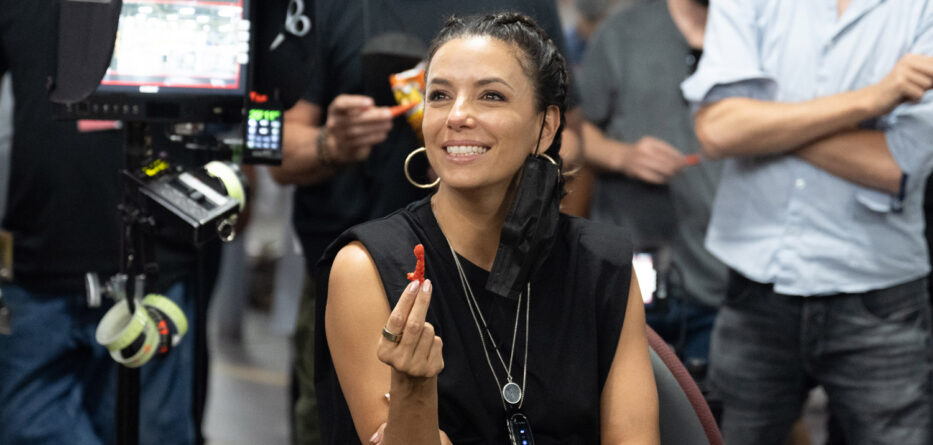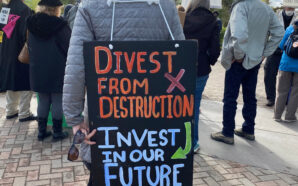Arturo Hilario
El Observador
Richard Montañez is not a name most grew up with, but a name that people might recall from now on, and possibly attach it to a popular snack name that everyone most definitely knows.
Montañez’s incredible story is one of perseverance, and gritty self-determination. From a janitor at Frito-Lay in Southern California to an Executive of Multicultural Marketing at PepsiCo, Montanez’s journey reflects the feel-good Latino stories that are lacking in the mainstream American media, his story is one where there is more heart and hope than there is tragedy and despair. Now his story has been brought to life by Eva Longoria with Flamin’ Hot.
Born in Corpus Christi, TX, Longoria is most known for her work as Gabrielle Solis on Desperate Housewives, a role that captivated audiences worldwide. From there she has continued acting as well as working behind the scenes, as a producer and director of projects like John Wick, Gordita Chronicles, and her recent TV series Eva Longoria: Searching for Mexico.
Flamin’ Hot, now streaming on both Hulu and Disney+, is Longoria’s feature film debut, and with 10 years of experience behind the camera, with TV shows and a documentary under her belt, the experience shows. There are also some firsts with the cast as well, with Jesse Garcia playing Richard Montañez in his first feature role, and Annie Gonzalez (Judy Montañez) in her first movie role. The veteran presence of Dennis Haysbert and Tony Shalhoub help bolster the film.
As evident by her more recent projects, Longoria has been delving more into her own culture, last year she directed La Guerra Civil, the documentary which recalls the Mexican versus Mexican-American rivalry that was spurred by one of the most iconic boxing matchups of the 90s, between Mexican boxer Julio César Chávez and Mexican-American boxer Oscar De La Hoya.
Recently she was in San Francisco while promoting Flamin’ Hot when she sat down to talk about how she became obsessed with making this movie, how Martin Scorsese and Ron Howard influenced her, what she feels is her superpower as a director, and why Richard Montañez’s story is one that needed to be told.
And despite the premise, Longoria makes sure to say that this is not simply the story of a chip, but the story of a man and his family, about his community; and that in spite of racism and classism Montañez’s achievements are some to be held up for people to see.
My North Star was authenticity, and I knew that was going to be my superpower. I know this community. This is my community. I know how to portray it. And this is why this movie is such a beautiful love letter to the Mexican American community, to the Chicano community, to the Cholo community. You’ve never seen them painted with a brush of so many colors.
To start out, what was it about Richard Montañez’s story that attracted you to this project?
Well, I read this script. This story was set up at Searchlight Pictures. They really believed in Richard’s story, and they sent me the script, and I read it, and I was like, “oh, my God.” I was blown away by his journey and his resilience. And then I was like, “Wait, he’s Mexican American. I’m Mexican American. How do I not know this story?!” Then I was sad that I didn’t know this story. If I’m from this community, why don’t we know who our heroes are?
And so I became obsessed with wanting to direct this film. And I went in and tried to get the job, had to pitch Searchlight four or five times, had to keep going back in and sharing my vision with them about the film I wanted to make. And then when I read the story, too, I was like, “I am Richard Montañez”. I’ve been told “no.” I’ve been told, “opportunities are not for people who look like you” and “you’re a girl. Maybe you shouldn’t do that job.” So I felt like the lesson that Richard teaches us is to ask, “Why not me? Why can’t I do something great? Why can’t I be great?” And so I got the job and was able to share the vision and my version of Richard’s really true, compelling story.
Did you have any inspirations you could talk about in terms of what you wanted the vibe of this movie to represent?
I had a lot, when you do a director’s presentation, you gotta present to them the movie you want to shoot. And I was trying to look at comparables to explain my vision to the studio, and there were none. I couldn’t find a movie from our community to point to that this was similar to.
So my inspirations were Scorsese, Adam McKay, Steven Spielberg, Ron Howard. And I really pulled references from those movies of, like, look what Scorsese did for the Italian American community’s knowledge of what that experience was in a period piece, in present day, in the 70s in Casino and Goodfellas. I was like, “oh, man. I love how he had an authentic point of view about that community.”
Ava DuVernay, she has a very specific point of view about the stories she wants to tell. And Ron Howard really directs movies with heart and that explore thematics on a different level. And he’s one of my mentors, and he said, “what is the movie about? Because it cannot be about the Cheeto.” And so I wanted to thematically explore what it means when opportunity is not distributed equally. Talent is, ambition is. But we all don’t get that opportunity to be great, to shine.
And so that’s what interested me, that’s the movie I wanted to make, was the journey of this man, and how, in spite of racism and classism and all the obstacles, he dealt with it with not only resilience, but he was resilient with dignity and grace. And I thought, wow, we could all learn from him.
Now, as this being your first feature film, I was wondering how that compares to your work directing Television. Are there any differences that you were surprised by in the process of directing?
No, this was a very ambitious schedule. So it was thanks to my ten years of directing TV that we went at the pace we went at, because I was used to it. I was like, no, we’re going to shoot this on a TV schedule, fast, scrappy. I slowed down when things needed scale and scope, but for the most part, it was an ambitious schedule to get, and I was really lucky I had the actors I had that came along, trusted me, moved at the pace we needed to move at, were totally prepared.
I had an amazing crew, almost all Latino department head crew that served my vision and improved it. They just delivered my vision times ten. And so for me, filmmaking is such a collaborative process, and my motto is, “best idea wins.” So ten brains are better than one. And I would present to them, “what do you guys think about this shot? What do you think about this sequence?” We had to build this entire factory. Everything you see is built by our production designers. And so to have those problem solvers on your team is really necessary and a blessing.
I was wondering why you think it’s important to bring to life these stories of people from our community, from Latinos?
My North Star was authenticity, and I knew that was going to be my superpower. I know this community. This is my community. I know how to portray it. And this is why this movie is such a beautiful love letter to the Mexican American community, to the Chicano community, to the Cholo community. You’ve never seen them painted with a brush of so many colors.
And so for me, I’m like, this is who we are. We’re hardworking, we’re ambitious, we’re faith based, we’re family oriented. We contribute a lot to our communities and our country. And so I wanted people to see what I know about our community and to see our worth on screen.
I also took to heart heavily the idea that Hollywood defines what heroes look like, and they never look like Richard, and they never look like us. And so to take this opportunity and create a hero that our community could look up at the big screen and see themselves reflected back at them was very important.
Could you touch on what it was like working with and directing the leads Jesse Garcia and Annie Gonzalez? And for them, I feel like it’s a big step being in the spotlight, being featured.
Well, I’ve always been a fan of Jesse’s. He’s been in the business 20 years, since Quinceañera. He’s been doing amazing work, but this is the first role he has had that shows the spectrum of his talent. We don’t get roles like this. We don’t get to play three different decades of a period piece, vulnerable, funny, dramatic, humorous, dangerous, kind.
He played all these amazing characters because he was different people at different points of his life, and he just knocked it out of the park. And I’m so happy for the world to finally see Jesse, for the talent that he is. He’s a force. He’s our movie star. He’s our Latino movie star. How many do we have? He’s in two movies right now. One with J-Lo and this one. That’s rare.
And Annie, I’m so excited for the world to be introduced to the talent that is Annie. She is a beautiful human being, but, wow, is she an amazing actress. And it wasn’t until we were doing this press tour where she said, “for this being my first movie,” and I was like, “wait, this was your first film?!” I didn’t even know that when we were shooting because she was such a pro and she was so skilled. And anything I said and anything I did, she was like, “yep, got it, great.”
She took direction insanely well. She made every scene better. Every scene that she was in, she made it better. And so I’m excited to introduce the world to Annie Gonzalez.
Last question. Now that Flamin’ Hot is out to stream on Hulu and Disney+, now it’s out for the world to see, what do you hope people take away from watching it?
Oh, man, I hope they’re inspired. I really love a feel-good movie, and you leave this movie feeling so good about life, so good about the possibilities, so good about dreaming big. And I want you to look at Richard’s life and go, “wow, if that guy survived all that and is thriving in spite of it, I can do anything.”






